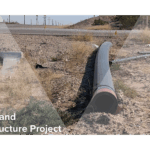
In the world of real estate and property transactions, one important aspect that cannot be overlooked is the process of conducting environmental site assessments. Specifically, in the case of Flower Mound, Texas, Phase 1 Environmental Site Assessments (ESAs) play a crucial role in determining the environmental risks associated with a particular property. Understanding the significance of these assessments, as well as the key components involved, is essential for anyone involved in property development or investment in Flower Mound.
Understanding Phase 1 Environmental Site Assessments
Phase 1 Environmental Site Assessments are an integral part of the due diligence process when it comes to property transactions. These assessments are conducted to evaluate the potential environmental risks and liabilities associated with a site. By conducting a Phase 1 ESA, property owners, buyers, and lenders gain valuable information about the historical use and possible contamination of a property. This enables them to make informed decisions and take appropriate actions when necessary.
The Importance of Phase 1 Assessments
Phase 1 Environmental Site Assessments are essential as they provide an overview of the potential environmental risks associated with a property. By conducting these assessments, stakeholders can identify any existing or potential contamination, which could impact the property’s value and pose risks to human health and the environment. Additionally, complying with environmental regulations and due diligence requirements is crucial to avoid legal and financial repercussions in the future.
Key Components of Phase 1 Assessments
Phase 1 Environmental Site Assessments involve a comprehensive investigation and analysis of several key components. These components typically include a thorough review of historical data, an on-site inspection, interviews with relevant parties, and a detailed report summarizing the findings. Each of these components contributes to providing a comprehensive understanding of the environmental risks associated with the property.
During the historical data review, environmental professionals meticulously examine records such as aerial photographs, topographic maps, and historical land-use records. This detailed analysis helps in identifying any past activities that might have contributed to contamination, such as the presence of underground storage tanks or hazardous waste disposal sites. By understanding the historical context of the property, stakeholders can gain insights into potential sources of contamination and evaluate the associated risks.
The on-site inspection is another crucial component of Phase 1 Assessments. Environmental professionals visit the property to visually inspect the site and its surroundings. They look for signs of potential contamination, such as stained soil, unusual odors, or the presence of abandoned equipment. The inspection also includes evaluating the property’s current land use and assessing the proximity of potential sources of contamination, such as industrial facilities or underground storage tanks in the vicinity. This on-site assessment provides valuable information about the current condition of the property and helps in identifying any visible signs of environmental risks.
The Process of Conducting Phase 1 Assessments in Flower Mound
The process of conducting Phase 1 Environmental Site Assessments in Flower Mound involves various stages. By following a systematic approach, environmental professionals can gather the necessary data and information to assess the potential environmental risks associated with a property.
Initial Site Inspection
The first stage of the Phase 1 ESA process is an on-site inspection. Environmental professionals visit the property and assess the current conditions, looking for any visible signs of contamination or potential sources of environmental risks. This inspection includes examining the surrounding area, land use history, and any previous industrial or commercial activities.
Historical Review of the Site
Another critical stage of Phase 1 Assessments is a detailed review of the property’s historical records. This involves researching land use records, historical aerial photographs, fire insurance maps, and other relevant documents to assess any potential contamination or environmental concerns associated with the property. The historical review provides valuable insights into the previous use of the property and the potential risks it may pose.
Interview and Documentation
Conducting interviews with current and previous property owners, occupants, and nearby businesses can provide further information about the property’s history and potential environmental risks. These interviews, combined with the collection of relevant documentation and permits, help environmental professionals build a comprehensive picture of the property’s environmental conditions.
Interpreting the Results of Phase 1 Assessments
Once the Phase 1 Environmental Site Assessment is complete, the findings need to be interpreted and analyzed. This step is crucial in determining the potential environmental risks associated with a property and identifying any necessary actions that should be taken.
Identifying Potential Environmental Risks
One of the primary goals of Phase 1 Assessments is to identify potential environmental risks associated with a property. The assessment helps highlight any recognized environmental conditions (RECs) or potential areas of concern that require further investigation. By identifying these risks, property owners can take appropriate measures to mitigate any potential liabilities.
Recommendations for Further Action
Based on the assessment findings, environmental professionals provide recommendations for further actions or additional investigations that may be necessary. These recommendations are tailored to address the specific environmental concerns associated with the property. Property owners, buyers, and lenders can then use these recommendations to make informed decisions and develop appropriate strategies to deal with any potential environmental risks.
Legal and Regulatory Aspects of Phase 1 Assessments
Understanding the legal and regulatory aspects related to Phase 1 Environmental Site Assessments is crucial for ensuring compliance and minimizing liability issues.
Federal and State Environmental Laws
Phase 1 Assessments in Flower Mound, like in other locations, need to adhere to federal and state environmental laws and regulations. These laws, such as the Comprehensive Environmental Response, Compensation, and Liability Act (CERCLA) and the Resource Conservation and Recovery Act (RCRA), help safeguard the environment and public health by regulating the management of hazardous substances.
Compliance and Liability Issues
Failure to comply with environmental regulations or neglecting to conduct Phase 1 Assessments can lead to significant legal and financial consequences. Non-compliance may result in legal action, penalties, potential cleanup costs, and hindrances in property transactions. By conducting thorough Phase 1 Assessments and addressing any identified issues proactively, stakeholders can minimize potential liabilities and ensure compliance with applicable laws.
The Role of Environmental Professionals in Phase 1 Assessments
Qualified environmental professionals play a crucial role in conducting Phase 1 Environmental Site Assessments. Their expertise and knowledge are vital in ensuring accurate assessments and identifying environmental risks associated with a property.
Qualifications and Responsibilities of Environmental Professionals
Environmental professionals involved in Phase 1 Assessments possess the necessary qualifications and credentials to conduct thorough investigations. They should have expertise in environmental science, geology, engineering, or a related field. Their responsibilities encompass conducting comprehensive assessments, interpreting findings, and providing recommendations for further actions.
Engaging with Environmental Professionals for Assessments
To ensure the quality and credibility of Phase 1 Assessments, it is crucial to engage with reputable environmental consulting firms or individual professionals with a proven track record. By working with experienced professionals, stakeholders can have confidence in the accuracy and reliability of the assessment results, thus making informed decisions regarding property transactions.
In conclusion, conducting Phase 1 Environmental Site Assessments in Flower Mound is a vital step in understanding the potential environmental risks associated with a property. These assessments provide valuable information to stakeholders involved in property development and investment, helping them make informed decisions, mitigate potential liabilities, and ensure compliance with environmental regulations. By engaging with qualified environmental professionals and following a systematic approach, property owners, buyers, and lenders can navigate the complex landscape of environmental assessments with confidence.
Ready to take the next step in ensuring your Flower Mound property is environmentally sound and compliant with regulations? Look no further than ESE Partners. Our team of seasoned environmental engineers and scientists is equipped to guide you through the complexities of Phase 1 Environmental Site Assessments and beyond. At ESE Partners, we’re committed to responsibly moving your business forward by addressing environmental challenges with innovative and sustainable solutions. Whether you require due diligence, remediation, or compliance services, we’re here to deliver honest, quality-driven results that not only recognize opportunities for stakeholders but also enhance the community’s quality of life. Don’t wait to secure your property’s future. Request A Proposal today and partner with a firm that understands the unique environmental needs of your business.








